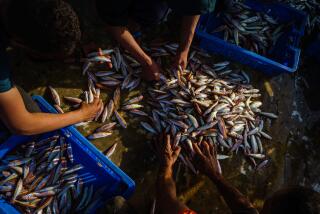Conservation Plan Puts Crocodiles on Dinner Plates
- Share via
HARARE, Zimbabwe — More people are eating crocodiles in Zimbabwe these days than there are crocodiles eating people.
Crocodiles--along with hippos--are the main wildlife killers of people in southern Africa.
Wildlife experts say crocodiles were killing a reported 20 to 30 people a year in Zimbabwe in the early 1980s, although the unreported toll could have been much higher. They have killed and eaten at least four people on Lake Kariba this year.
Lightning fast in attack and growing up to 40 feet in length, the reptiles have a fearsome reputation.
But Zimbabwe has turned them into an economic asset, leading the way in conserving wildlife through what experts describe as “sustainable use.”
Crocodile skins produce quality leather valued by the high-fashion industry.
And people--mainly tourists--are eating their way through about nine tons of meat a year from three abattoirs licensed to European standards and supplied by 44 farms.
Some crocodile meat is being exported to France and Britain.
In Zimbabwe, only whites eat crocodile meat, which tastes like chewy lobster tail.
“We don’t eat creatures that eat us. You don’t know what you might be eating,” one African said.
This is in sharp contrast to Zaire and Congo, where the dwarf crocodile is a valued local delicacy. The skin is roasted and eaten like pork crackling.
Zimbabwe’s aim is to conserve and promote its wildlife by making animals and reptiles of economic value to local people with whom they share increasingly crowded living space.
Wildlife experts say Zimbabwe’s pioneering Campfire Project is proving that people can live with wild animals--even those that threaten lives and crops--and help to protect them if they can make money out of it.
Jonathan Hutton, an environmental expert who is executive director of the Crocodile Farmers’ Assn. of Zimbabwe, said crocodile farming started in Zimbabwe in the early 1960s as a conservation method after heavy hunting had ravaged the crocodile population.
It has turned into an economic asset for the country and for local people who get paid $5 ($1 U.S.) for each egg found in their locality. The crocodile population stands at the highest on record, about 30,000 in Lake Kariba alone.
Two percent of farm-hatched crocodiles are returned to the wild. Experts say this is a higher survival rate than if the eggs were left to hatch by themselves.
“Last year, crocodiles earned about 3 million U.S. dollars for Zimbabwe,” Hutton said, adding that crocodile farming has spread to Ethiopia, Kenya, Uganda, Tanzania, Zambia, Mozambique, Botswana and Madagascar.
“Similar experiments are also under way in Indonesia, Australia and the United States, in Louisiana and Florida,” he said.
The U.S. reptile farms created a market crisis this year, however. In 1989, Hutton said, U.S. reptile farms took in 200,000 eggs and the skins started appearing on the market at the end of 1990.
The number of available skins doubled in a year and prices fell to $10 an inch from a peak of $19 an inch in 1990.
Hutton said there were two options: Expand demand or reduce production.
He was optimistic that demand could be widened. Legitimate conservation measures were overcoming objections among mainly Western animal lovers about the commercial use of skins, he said.
Hutton said an international specialist group was set up in 1986 with a five-year aim to eradicate the illegal trade in crocodiles and promote “sustained-use crocodile programs.”
He said the illegal trade in “classic” crocodile skins for the high-value fashion industry has been eliminated. “Classic” skins accounted for less than 25% of world trade.
The next target was the illegal trade in low-value caiman skins from Central and South America.
Hutton said it would be futile to attack the producer end of the caiman trade, but users could be pressured into taking only legal skins. The two biggest offenders, he said, were the fashion industries in Italy and Singapore, and these could be brought into line by threat of boycott.
The 103-nation Convention on International Trade in Endangered Species (CITES) is due to meet in Tokyo in March. Hutton said there would be a moratorium on all trade with Italy and Singapore if they did not comply.
He said the reason there had been general agreement on regulating and legalizing the trade was to allow the industry to “go out and promote crocodile leather products based on conservation.”
“It is entrenched now in Western thinking that all wildlife trade is bad, and that kind of thinking is gradually decreasing the sustained yield conservation options.
“The day we stop taking crocodile eggs from the wild and paying local people for them, their conservation use disappears and crocodiles just become a pest eating people,” Hutton said.
More to Read
Sign up for Essential California
The most important California stories and recommendations in your inbox every morning.
You may occasionally receive promotional content from the Los Angeles Times.













